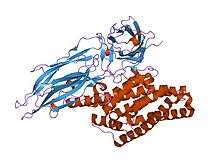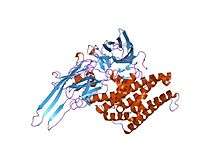Delta endotoxin
Delta endotoxins (δ-endotoxins) are pore-forming toxins produced by Bacillus thuringiensis species of bacteria. They are useful for their insecticidal action and are the primary toxin produced by Bt corn. During spore formation the bacteria produce crystals of such proteins (hence the name Cry toxins) that are also known as parasporal bodies, next to the endospores; as a result some members are known as a parasporin. The Cyt (cytolytic) toxin group is a group of delta-endotoxins different from the Cry group.
| delta endotoxin, N-terminal domain | |||||||||
|---|---|---|---|---|---|---|---|---|---|
 | |||||||||
| Identifiers | |||||||||
| Symbol | Endotoxin_N | ||||||||
| Pfam | PF03945 | ||||||||
| InterPro | IPR005639 | ||||||||
| SCOPe | 1dlc / SUPFAM | ||||||||
| TCDB | 1.C.2 | ||||||||
| |||||||||
| delta endotoxin, middle domain | |||||||||
|---|---|---|---|---|---|---|---|---|---|
| Identifiers | |||||||||
| Symbol | Endotoxin_M | ||||||||
| Pfam | PF00555 | ||||||||
| Pfam clan | CL0568 | ||||||||
| InterPro | IPR015790 | ||||||||
| SCOPe | 1dlc / SUPFAM | ||||||||
| TCDB | 1.C.2 | ||||||||
| |||||||||
| delta endotoxin, middle domain, Cry2A and Cry18 | |||||||||
|---|---|---|---|---|---|---|---|---|---|
 insecticidal crystal protein cry2aa | |||||||||
| Identifiers | |||||||||
| Symbol | Endotoxin_mid | ||||||||
| Pfam | PF09131 | ||||||||
| InterPro | IPR015214 | ||||||||
| SCOPe | 1i5p / SUPFAM | ||||||||
| |||||||||
| delta endotoxin, C-terminal | |||||||||
|---|---|---|---|---|---|---|---|---|---|
| Identifiers | |||||||||
| Symbol | Endotoxin_C | ||||||||
| Pfam | PF03944 | ||||||||
| Pfam clan | CL0202 | ||||||||
| InterPro | IPR005638 | ||||||||
| SCOPe | 1dlc / SUPFAM | ||||||||
| TCDB | 1.C.2 | ||||||||
| CDD | cd04085 | ||||||||
| |||||||||
| Cytolytic Delta-endotoxin Cyt1/2 | |||||||||
|---|---|---|---|---|---|---|---|---|---|
| Identifiers | |||||||||
| Symbol | CytB | ||||||||
| Pfam | PF01338 | ||||||||
| InterPro | IPR001615 | ||||||||
| SCOPe | 1cby / SUPFAM | ||||||||
| TCDB | 1.C.71 | ||||||||
| |||||||||
Mechanism of action
When an insect ingests these proteins, they are activated by proteolytic cleavage. The N-terminus is cleaved in all of the proteins and a C-terminal extension is cleaved in some members. Once activated, the endotoxin binds to the gut epithelium and causes cell lysis by the formation of cation-selective channels, which leads to death.[2][1]
Structure
The activated region of the delta toxin is composed of three distinct structural domains: an N-terminal helical bundle domain (InterPro: IPR005639) involved in membrane insertion and pore formation; a beta-sheet central domain involved in receptor binding; and a C-terminal beta-sandwich domain (InterPro: IPR005638) that interacts with the N-terminal domain to form a channel.[1][2]
Types
B. thuringiensis encodes many proteins of the delta endotoxin family (InterPro: IPR038979), with some strains encoding multiple types simultaneously.[3] A gene mostly found on plasmids,[4] delta-entotoxins sometimes show up in genomes of other species, albeit at a lower proportion than those found in B. Thuringiensis.[5] The gene names looks like Cry3Bb, which in this case indicates a Cry toxin of superfamily 3 family B subfamily b.[6]
Cry proteins that are interesting to cancer research are listed under a parasporin (PS) nomenclature in addition to the Cry nomenclature. They do not kill insects, but instead kill leukemia cells.[7][8][9] The Cyt toxins tend to form their own group distinct from Cry toxins.[10] Not all Cry -- crystal-form -- toxins directly share a common root.[11] Examples of non-three-domain toxins that nevertheless have a Cry name include Cry34/35Ab1 and related beta-sandwich binary (Bin-like) toxins, Cry6Aa, and many beta-sandwich parasporins.[12]
Specific delta-endotoxins that has been used for genetic engineering include Cry3Bb1 found in MON 863 and Cry1Ab found in MON 810, both of which are corn species. Cry3Bb1 is particularly useful because it kills the coleopteran insects such as the corn rootworm, an activity not seen in other Cry proteins.[1] Other common toxins include Cry2Ab and Cry1F in cotton and corn.[13] In addition, Cry1Ac is effective as a vaccine adjuvant in humans.[14]
Some insects populations have started to develop resistance towards delta endotoxin, with five resistant species found as of 2013. Plants with two kinds of delta endotoxins tend to make resistance happen slower, as the insects have to evolve to overcome both toxins at once. Planting non-Bt plants with the resistant plants will reduce the selection pressure for developing the toxin. Finally, two-toxin plants should not be planted with one-toxin plants, as one-toxin plants act as a stepping stone for adaption in this case.[13]
References
- Galitsky N, Cody V, Wojtczak A, Ghosh D, Luft JR, Pangborn W, English L (August 2001). "Structure of the insecticidal bacterial delta-endotoxin Cry3Bb1 of Bacillus thuringiensis". Acta Crystallographica. Section D, Biological Crystallography. 57 (Pt 8): 1101–9. doi:10.1107/S0907444901008186. PMID 11468393.
- Grochulski P, Masson L, Borisova S, Pusztai-Carey M, Schwartz JL, Brousseau R, Cygler M (December 1995). "Bacillus thuringiensis CryIA(a) insecticidal toxin: crystal structure and channel formation". Journal of Molecular Biology. 254 (3): 447–64. doi:10.1006/jmbi.1995.0630. PMID 7490762.
- "Pesticidal crystal protein (IPR038979)". InterPro. Retrieved 12 April 2019.
- Dean DH (1984). "Biochemical genetics of the bacterial insect-control agent Bacillus thuringiensis: basic principles and prospects for genetic engineering" (PDF). Biotechnology & Genetic Engineering Reviews. 2: 341–63. doi:10.1080/02648725.1984.10647804. PMID 6443645.
- "Species: Pesticidal crystal protein (IPR038979)". InterPro.
- "Bacillus thuringiensis Toxin Nomenclature". Bt toxin specificity database. Retrieved 12 April 2019.
- Mizuki E, Park YS, Saitoh H, Yamashita S, Akao T, Higuchi K, Ohba M (July 2000). "Parasporin, a human leukemic cell-recognizing parasporal protein of Bacillus thuringiensis". Clinical and Diagnostic Laboratory Immunology. 7 (4): 625–34. doi:10.1128/CDLI.7.4.625-634.2000. PMC 95925. PMID 10882663.
- Ohba M, Mizuki E, Uemori A (January 2009). "Parasporin, a new anticancer protein group from Bacillus thuringiensis". Anticancer Research. 29 (1): 427–33. PMID 19331182.
- "List of Parasporins". Committee of Parasporin Classification and Nomenclature. Accessed Jan 4, 2013
- Crickmore N. "Other Cry Seqences" (PDF). Retrieved 12 April 2019.
- Crickmore N, Zeigler DR, Feitelson J, Schnepf E, Van Rie J, Lereclus D, et al. (September 1998). "Revision of the nomenclature for the Bacillus thuringiensis pesticidal crystal proteins" (PDF). Microbiology and Molecular Biology Reviews. 62 (3): 807–13. PMC 98935. PMID 9729610.
- Kelker MS, Berry C, Evans SL, Pai R, McCaskill DG, Wang NX, et al. (2014-11-12). "Structural and biophysical characterization of Bacillus thuringiensis insecticidal proteins Cry34Ab1 and Cry35Ab1". PLOS ONE. 9 (11): e112555. Bibcode:2014PLoSO...9k2555K. doi:10.1371/journal.pone.0112555. PMC 4229197. PMID 25390338.
- Tabashnik BE, Brévault T, Carrière Y (June 2013). "Insect resistance to Bt crops: lessons from the first billion acres". Nature Biotechnology. 31 (6): 510–21. doi:10.1038/nbt.2597. PMID 23752438.
- Rodriguez-Monroy MA, Moreno-Fierros L (March 2010). "Striking activation of NALT and nasal passages lymphocytes induced by intranasal immunization with Cry1Ac protoxin". Scandinavian Journal of Immunology. 71 (3): 159–68. doi:10.1111/j.1365-3083.2009.02358.x. PMID 20415781.
Further reading
- Bravo A, Gill SS, Soberón M (March 2007). "Mode of action of Bacillus thuringiensis Cry and Cyt toxins and their potential for insect control". Toxicon. 49 (4): 423–35. doi:10.1016/j.toxicon.2006.11.022. PMC 1857359. PMID 17198720.
- Pigott CR, Ellar DJ (June 2007). "Role of receptors in Bacillus thuringiensis crystal toxin activity". Microbiology and Molecular Biology Reviews. 71 (2): 255–81. doi:10.1128/MMBR.00034-06. PMC 1899880. PMID 17554045.
- Palma L, Muñoz D, Berry C, Murillo J, Caballero P (December 2014). "Bacillus thuringiensis toxins: an overview of their biocidal activity". Toxins. 6 (12): 3296–325. doi:10.3390/toxins6123296. PMC 4280536. PMID 25514092.